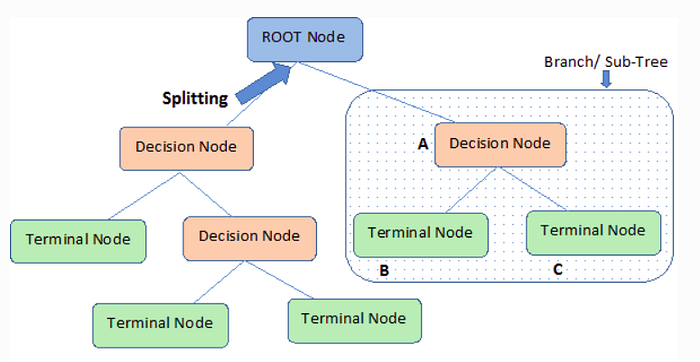
Decision Tree Terminology :
- Root node : is the first node in decision trees
- Splitting : is a process of dividing node into two or more sub-nodes, starting from the root node
- Node : splitting results from the root node into sub-nodes and splitting sub-nodes into further sub-nodes
- Leaf or terminal node : end of a node, since node cannot be split anymore
- Pruning : is a technique to reduce the size of the decision tree by removing sub-nodes of the decision tree. The aim is reducing complexity for improved predictive accuracy and to avoid overfitting
- Branch / Sub-Tree : A subsection of the entire tree is called branch or sub-tree.
- Parent and Child Node: A node, which is divided into sub-nodes is called parent node of sub-nodes whereas sub-nodes are the child of parent node.
Decision Tree:
A Decision tree works by asking a series of questions to the data each question narrowing our possible values until the model get confident enough to make a single prediction. The order of the question as well as their content are being determined by the model. In addition, the questions asked are all in a True/False form.
A decision tree learns to map data to outputs in training phase of model building.During training, the model is fitted with any historical data that is relevant to the problem domain and the true value we want the model to learn to predict. The model learns any relationships between the data and the target variable.
After the training phase, the decision tree produces a tree similar to the one shown above, calculating the best questions as well as their order to ask in order to make the most accurate estimates possible. When we want to make a prediction the same data format should be provided to the model in order to make a prediction. The prediction will be an estimate based on the train data that it has been trained on.
How is Splitting Decided for Decision Trees?
The decision of making strategic splits affects the accuracy of the model.The splitting criteria is different for classification and regression problems.
Decision trees use multiple algorithms to decide to split a node into two or more sub-nodes.The creation of sub-nodes increases the homogeneity of resultant sub-nodes. In other words, we can say that the purity of the node increases with respect to the target variable. The decision tree splits the nodes on all available variables and then selects the split which results in most homogeneous sub-nodes.
The algorithm selection is also based on the type of target variables. Let us look at some algorithms used in Decision Trees:
ID3 → (extension of D3)
C4.5 → (successor of ID3)
CART → (Classification And Regression Tree)
CHAID → (Chi-square automatic interaction detection Performs multi-level splits when computing classification trees)
MARS → (multivariate adaptive regression splines)
The ID3 algorithm builds decision trees using a top-down greedy search approach through the space of possible branches with no backtracking. A greedy algorithm, as the name suggests, always makes the choice that seems to be the best at that moment.
Steps in ID3 algorithm:
- It begins with the original set S as the root node.
- On each iteration of the algorithm, it iterates through the very unused attribute of the set S and calculates Entropy(H) and Information gain(IG) of this attribute.
- It then selects the attribute which has the smallest Entropy or Largest Information gain.
- The set S is then split by the selected attribute to produce a subset of the data.
- The algorithm continues to recur on each subset, considering only attributes never selected before.
Attribute Selection Measures
If the dataset consists of N attributes then deciding which attribute to place at the root or at different levels of the tree as internal nodes is a complicated step. By just randomly selecting any node to be the root can’t solve the issue. If we follow a random approach, it may give us bad results with low accuracy.
For solving this attribute selection problem, researchers worked and devised some solutions. They suggested using some criteria like :
Entropy,
Information gain,
Gini index,
Gain Ratio,
Reduction in Variance
Chi-Square
These criteria will calculate values for every attribute. The values are sorted, and attributes are placed in the tree by following the order i.e, the attribute with a high value(in case of information gain) is placed at the root.
While using Information Gain as a criterion, we assume attributes to be categorical, and for the Gini index, attributes are assumed to be continuous.
Entropy:
Entropy is a measure of the randomness in the information being processed. The higher the entropy, the harder it is to draw any conclusions from that information. Flipping a coin is an example of an action that provides information that is random.

From the above graph, it is quite evident that the entropy H(X) is zero when the probability is either 0 or 1. The Entropy is maximum when the probability is 0.5 because it projects perfect randomness in the data and there is no chance if perfectly determining the outcome.
ID3 follows the rule — A branch with an entropy of zero is a leaf node and A brach with entropy more than zero needs further splitting.
Mathematically Entropy for 1 attribute is represented as:

Where S → Current state, and Pi → Probability of an event i of state S or Percentage of class i in a node of state S.
Mathematically Entropy for multiple attributes is represented as:
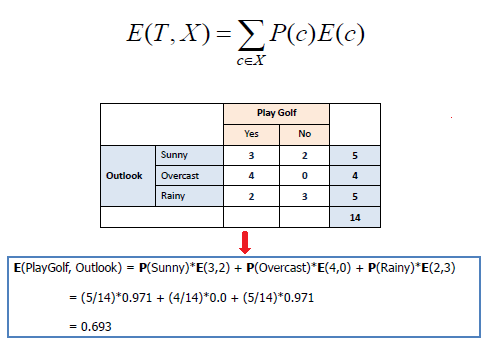
where T→ Current state and X → Selected attribute
Information Gain:
Information gain or IG is a statistical property that measures how well a given attribute separates the training examples according to their target classification. Constructing a decision tree is all about finding an attribute that returns the highest information gain and the smallest entropy.
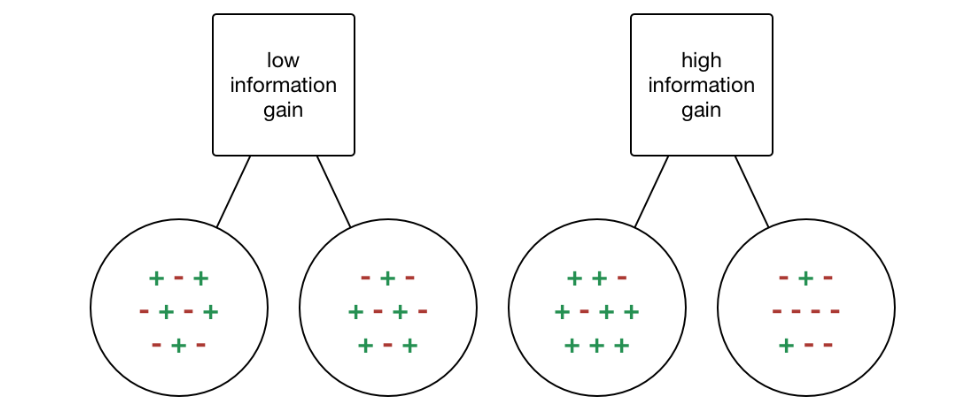
Information gain is a decrease in entropy. It computes the difference between entropy before split and average entropy after split of the dataset based on given attribute values. ID3 (Iterative Dichotomiser) decision tree algorithm uses information gain.
Mathematically, IG is represented as:
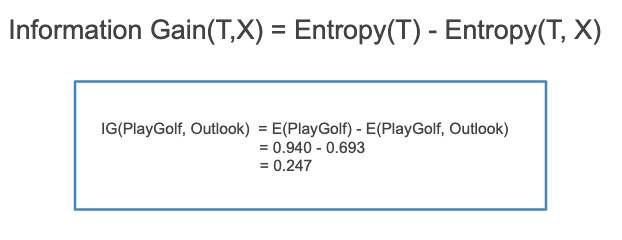
In a much simpler way, we can conclude that:

Where “before” is the dataset before the split, K is the number of subsets generated by the split, and (j, after) is subset j after the split.
Gini Index:
You can understand the Gini index as a cost function used to evaluate splits in the dataset. It is calculated by subtracting the sum of the squared probabilities of each class from one. It favors larger partitions and easy to implement whereas information gain favors smaller partitions with distinct values.

Gini Index works with the categorical target variable “Success” or “Failure”. It performs only Binary splits.
Higher value of Gini index implies higher inequality, higher heterogeneity.
Steps to Calculate Gini index for a split:
- Calculate Gini for sub-nodes, using the above formula for success(p) and failure(q) (p²+q²).
- Calculate the Gini index for split using the weighted Gini score of each node of that split.
Gain ratio:
Information gain is biased towards choosing attributes with a large number of values as root nodes. It means it prefers the attribute with a large number of distinct values.
C4.5, an improvement of ID3, uses Gain ratio which is a modification of Information gain that reduces its bias and is usually the best option. Gain ratio overcomes the problem with information gain by taking into account the number of branches that would result before making the split. It corrects information gain by taking the intrinsic information of a split into account.
Let us consider if we have a dataset that has users and their movie genre preferences based on variables like gender, group of age, rating, blah, blah. With the help of information gain, you split at ‘Gender’ (assuming it has the highest information gain) and now the variables ‘Group of Age’ and ‘Rating’ could be equally important and with the help of gain ratio, it will penalize a variable with more distinct values which will help us decide the split at the next level.

Where “before” is the dataset before the split, K is the number of subsets generated by the split, and (j, after) is subset j after the split.
Reduction in Variance:
Reduction in variance is an algorithm used for continuous target variables (regression problems). This algorithm uses the standard formula of variance to choose the best split. The split with lower variance is selected as the criteria to split the population.

Above X-bar is the mean of the values, X is actual and n is the number of values.
Steps to calculate Variance:
- Calculate variance for each node.
- Calculate variance for each split as the weighted average of each node variance.
Chi-Square:
The acronym CHAID stands for Chi-squared Automatic Interaction Detector. It is one of the oldest tree classification methods. It finds out the statistical significance between the differences between sub-nodes and parent node. We measure it by the sum of squares of standardized differences between observed and expected frequencies of the target variable.
It works with the categorical target variable “Success” or “Failure”. It can perform two or more splits. Higher the value of Chi-Square higher the statistical significance of differences between sub-node and Parent node.
It generates a tree called CHAID (Chi-square Automatic Interaction Detector).
Mathematically, Chi-squared is represented as:
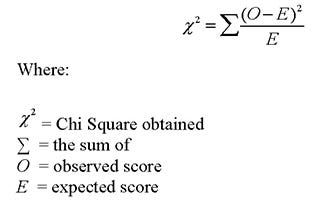
Steps to Calculate Chi-square for a split:
- Calculate Chi-square for an individual node by calculating the deviation for Success and Failure both
- Calculated Chi-square of Split using Sum of all Chi-square of success and Failure of each node of the split
How to avoid/counter Overfitting in Decision Trees?
The common problem with Decision trees, especially having a table full of columns, they fit a lot. Sometimes it looks like the tree memorized the training data set. If there is no limit set on a decision tree, it will give you 100% accuracy on the training data set because in the worse case it will end up making 1 leaf for each observation. Thus this affects the accuracy when predicting samples that are not part of the training set.
Here are two ways to remove overfitting:
- Pruning Decision Trees.
- Random Forest
Pruning Decision Trees
The splitting process results in fully grown trees until the stopping criteria are reached. But, the fully grown tree is likely to overfit the data, leading to poor accuracy on unseen data.
In pruning, you trim off the branches of the tree, i.e., remove the decision nodes starting from the leaf node such that the overall accuracy is not disturbed. This is done by segregating the actual training set into two sets: training data set, D and validation data set, V. Prepare the decision tree using the segregated training data set, D. Then continue trimming the tree accordingly to optimize the accuracy of the validation data set, V.
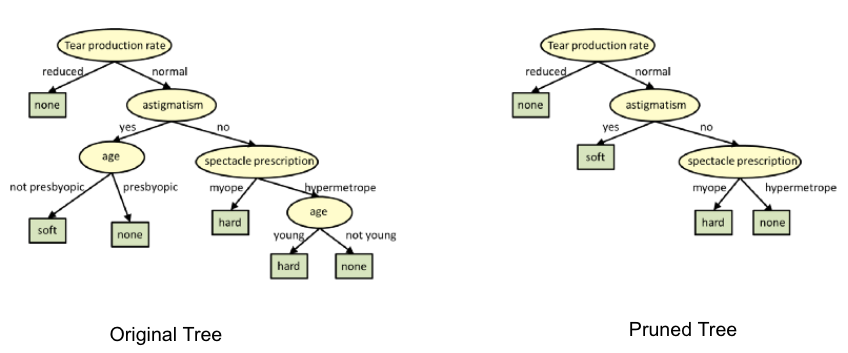
In the above diagram, the ‘Age’ attribute in the left-hand side of the tree has been pruned as it has more importance on the right-hand side of the tree, hence removing overfitting.
Random Forest:
Random Forest is an example of ensemble learning, in which we combine multiple machine learning algorithms to obtain better predictive performance.
Why the name “Random”?
Two key concepts that give it the name random:
- A random sampling of training data set when building trees.
- Random subsets of features considered when splitting nodes.
A technique known as bagging is used to create an ensemble of trees where multiple training sets are generated with replacement.
In the bagging technique, a data set is divided into N samples using randomized sampling. Then, using a single learning algorithm a model is built on all samples. Later, the resultant predictions are combined using voting or averaging in parallel.
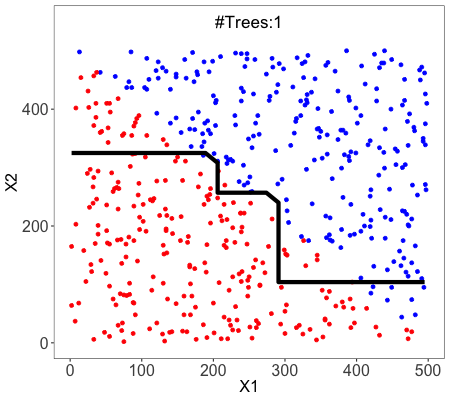
Which is better Linear or tree-based models?
Well, it depends on the kind of problem you are solving.
- If the relationship between dependent & independent variables is well approximated by a linear model, linear regression will outperform the tree-based model.
- If there is a high non-linearity & complex relationship between dependent & independent variables, a tree model will outperform a classical regression method.
- If you need to build a model that is easy to explain to people, a decision tree model will always do better than a linear model. Decision tree models are even simpler to interpret than linear regression!
***Thank you***

0 Response to "Decision Tree"
Post a Comment